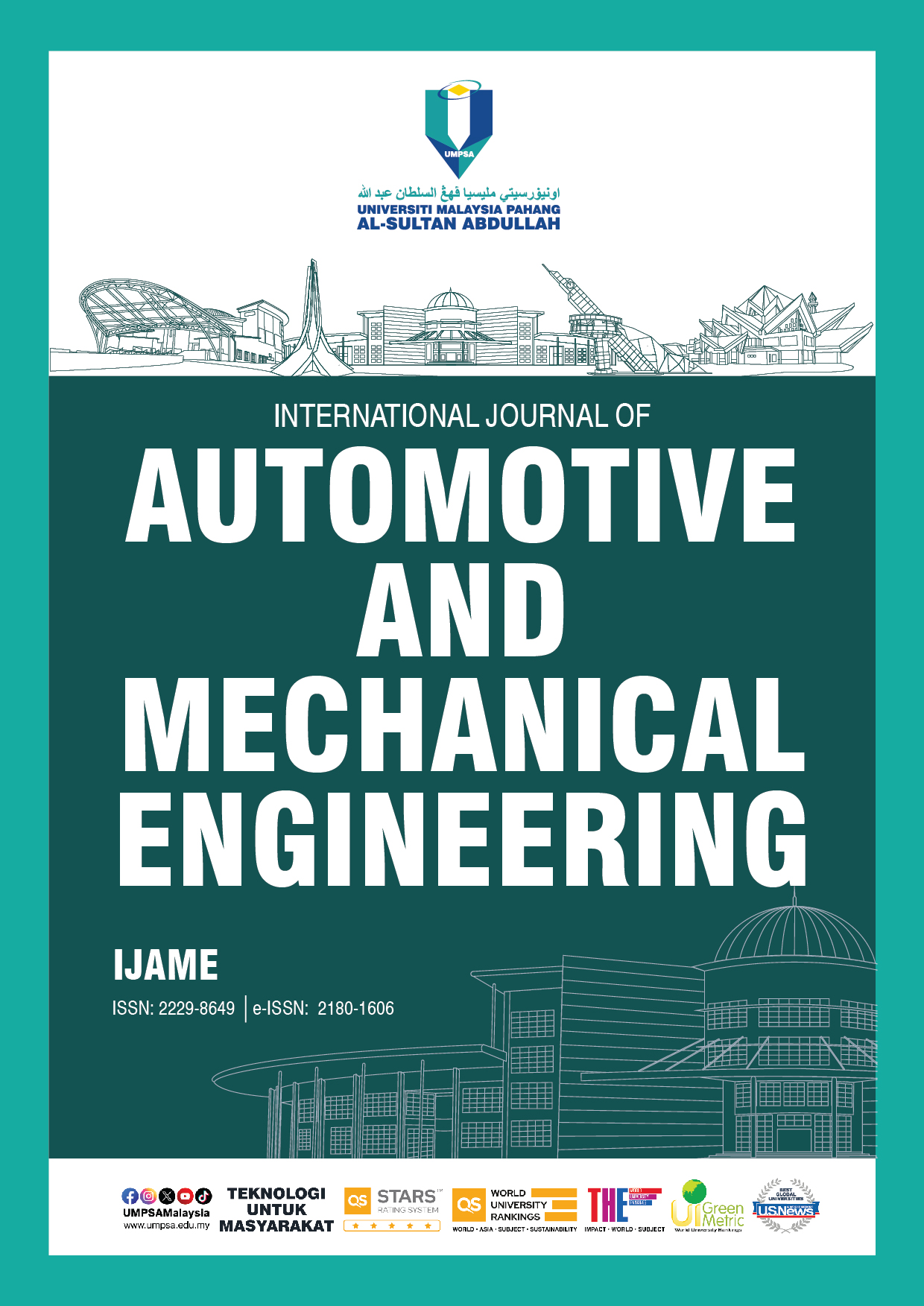Computational Fluid Dynamics Analysis of Aerodynamic Characteristics on Overtaking Vehicles in Crosswind Conditions
DOI:
https://doi.org/10.15282/ijame.22.2.2025.10.0947Keywords:
Overtaking maneuver, Crosswind, Aerodynamic loads, Flow structure, Vortex generation, CFDAbstract
Drivers frequently adjust their path due to crosswinds and overtaking, where adjacent vehicles significantly alter airflow. This study uses computational fluid dynamics to analyze the aerodynamic impact of overtaking maneuvers on simplified car models (Ahmed Bodies) under crosswind conditions. The investigation focuses on how drag, lift, and side force coefficients change during different overtaking stages at varying crosswind angles (0°, 15°, 30°, and 45°). The study focused on 2 Ahmed Body models, which are overtaking vehicle(A) and overtaking vehicle(B), in 5 different cases: before overtake, initiation of overtake, mid-overtake, completion of overtake, and after overtake. Results show that at a 15° crosswind, Car A has a higher drag coefficient (Cd: 0.3916), reducing performance and stability. At 30°, Car A shows a high lift coefficient (Cl: 0.9881); at 45°, Car B experiences a significant increase in side force coefficient (Cs: 3.1192). This is due to the pressure contour at the front corner of the vehicle surface and the vortex formation on the leeward side of the vehicles as yaw angles rise. Results show that crosswinds significantly increase aerodynamic forces and alter flow structures around vehicles. Specifically, the relative position of vehicles during overtaking greatly influences these forces, affecting vehicle stability.
References
[1] N. Chen, H. Sun, X. Wang, and L. Zhang, “The aerodynamic characteristics of road vehicles overtaking on bridge deck under crosswinds,” Advances in Civil Engineering, vol. 2020, no. 1, p. 8847219, 2020.
[2] W. C. Lim, I. Amin Ishak, M. Arafat, M. Nabil Farhan Kamal, N. Afzanizam Samiran, and A. Faiz Mohammad, “Analysis of the aerodynamic characteristics of small-sized car vehicles under the influence of steady crosswind,” International Journal of Application on Sciences Technology and Engineering, vol. 1, no. 1, pp. 217–224, 2023.
[3] M. P. Ismail, I. A. Ishak, N. A. Samiran, A. F. Mohammad, Z. Mohd Salleh, and N. Darlis, “CFD analysis on the effect of vortex generator on sedan car using ANSYS software,” International Journal of Integrated Engineering, vol. 14, no. 1, pp. 73–83, 2022.
[4] H. Sun, E. Karadimitriou, X. M. Li, and D. Mathioulakis, “Aerodynamic interference between two road vehicle models during overtaking,” Journal of Energy Engineering, vol. 145, no. 2, p. 04019002, 2019.
[5] A. Yudianto, H. Sofyan, and N. A. Fauzi, “Aerodynamic characteristics of overtaking bus under crosswind: CFD investigation,” CFD Letters, vol. 14, no. 8, pp. 20–32, 2022.
[6] B. J. Tayade and P. S. Bajaj, “A review on the effect of aerodynamics on car overtaking truck using CFD analysis method,” International Research Journal of Engineering and Technology, vol. 9, no. 8, pp. 1273–1279, 2022.
[7] M. N. F. Kamal, I. A. Ishak, N. Darlis, N. M. Maruai, R. Jamian, R. A. Rashid, “Flow structure characteristics of the simplified compact car exposed to crosswind effects using CFD,” Journal of Advanced Research in Applied Sciences and Engineering Technology, vol. 28, no. 1, pp. 56–66, 2022.
[8] M. N. F. Kamal, I. A. Ishak, N. Darlis, D. S. B. Maji, S. L. Sukiman, R. Abd Rashid, et al., “A review of aerodynamics influence on various car model geometry through CFD techniques,” Journal of Advanced Research in Fluid Mechanics and Thermal Sciences, vol. 88, no. 1, pp. 109–125, 2021.
[9] N. Chen, X. Wang, S. Li, and H. Xiang, “Safety analysis of road vehicles overtake on cables-Stayed bridge under crosswinds,” Advances in Structural Engineering, vol. 26, no. 5, pp. 870–887, 2023.
[10] A. Brandt, B. Jacobson, and S. Sebben, “High speed driving stability of road vehicles under crosswinds: an aerodynamic and vehicle dynamic parametric sensitivity analysis,” Vehicle System Dynamics, vol. 60, no. 7, p. 2334-2357, 2021.
[11] C. Noger and E. Van Grevenynghe, “On the transient aerodynamic forces induced on heavy and light vehicles in overtaking processes,” International Journal of Aerodynamics, vol. 1, no. 3/4, p. 373, 2011.
[12] D. Uystepruyst and S. Krajnović, “Numerical simulation of the transient aerodynamic phenomena induced by passing manoeuvres,” Journal of Wind Engineering and Industrial Aerodynamics, vol. 114, pp. 62–71, 2013.
[13] C. Su, Z. Hu, Q. Zhang, X. Yuan, C. Zhang, and Y. Wang, “Coupling analysis of transient aerodynamic and dynamic response of cars in overtaking under crosswinds,” Engineering Applications of Computational Fluid Mechanics, vol. 14, no. 1, pp. 1215–1227, 2020.
[14] T. Nakashima, C. Yan, T. Moriuchi, I. Kohri, H. Mutsuda, and Y. Doi, “Active aerodynamics control of simplified vehicle body in a crosswind condition,” The Journal of Engineering, vol. 2020, no. 14, pp. 1005–1011, 2020.
[15] S. D. Marshall, K. Snape, D. Soper, M. Sterling, and S. Gillmeier, “The aerodynamic performance of a platoon of lorries in close-proximity during an overtaking manoeuvre,” Frontiers in Future Transportation, vol. 5, p. 1356539, 2024.
[16] M. Tsubokura, T. Nakashima, M. Kitayama, Y. Ikawa, D. H. Doh, and T. Kobayashi, “Large eddy simulation on the unsteady aerodynamic response of a road vehicle in transient crosswinds,” International Journal of Heat and Fluid Flow, vol. 31, no. 6, pp. 1075–1086, 2010.
[17] J. Liu, Z. Gu, T. Huang, S. Li, L. Zheng, and K. Sun, “Coupled analysis of the unsteady aerodynamics and multi-body dynamics of a small car overtaking a coach,” Proceedings of the Institution of Mechanical Engineers, Part D: Journal of Automobile Engineering, vol. 233, no. 14, pp. 3684–3699, 2019.
[18] H. Zhou, Q. Chen, R. Qin, L. Zhang, and H. Li, “Investigation of wheelhouse shapes on the aerodynamic characteristics of a generic car model,” Advances in Mechanical Engineering, vol. 13, no. 12, p. 16878140211066842, 2021.
[19] D. Weng, “Numerical simulations on aerodynamic drag reduction of a 25° Ahmed body by jet flow,” Science and Technology of Engineering, Chemistry and Environmental Protection, vol. 1, no. 9, pp. 1-11, 2024.
[20] J. Sun, L. Zhang, and Y. He, “Vehicle aerodynamics characteristics of 35°Ahmed body model in crosswind conditions,” Journal of Physics: Conference Series, vol. 2951, no. 1, p. 012036, 2025.
[21] S. S. Al Homoud, D. Harmanto, and I. Oraifige, “An investigation into the effect of drag coefficient on overtaking of car,” Applied Mechanics and Materials, vol. 493, pp. 151–154, 2014.
[22] Z. Yuan, Z. Gu, Y. Wang, and X. Huang, “Numerical investigation for the influence of the car underbody on aerodynamic force and flow structure evolution in crosswind,” Advances in Mechanical Engineering, vol. 10, no. 10, p. 168781401879750, 2018.
[23] M. He, S. Huo, H. Hemida, D. Soper, M. Sterling, and C. Baker, “The flow around a lorry platoon subject to a crosswind—a detached eddy simulation,” Frontiers in Future Transportation, vol. 3, p. 901204, 2022.
[24] W. Meile, G. Brenn, A. Reppenhagen, B. Lechner, and A. Fuchs, “Experiments and numerical simulations on the aerodynamics of the Ahmed body,” CFD Letters, vol. 3, no. 1, pp. 32–38, 2011.
[25] H. Zhou, R. Qin, G. Wang, L. Xin, Q. Wang, and Z. Zheng, “Comparative analysis of the aerodynamic behavior on Ahmed body mounted with different wheel configurations,” Proceedings of the Institution of Mechanical Engineers, Part D: Journal of Automobile Engineering, vol. 238, no. 1, pp. 128–146, 2024.
[26] F. H. Harlow and J. E. Welch, “Numerical calculation of time-dependent viscous incompressible flow of fluid with free surface,” Physics of Fluids, vol. 8, no. 12, pp. 2182–2189, 1965.
[27] I. A. Ishak, M. S. M. Alia, and S. A. Z. S. Salim, “Mesh size refining for a simulation of flow around a generic train model,” Wind and Structures, vol. 24, no. 3, pp. 223–247, 2017.
[28] M. Arafat, I. A. Ishak, and A. F. Mohammad, “Influence of mesh refinement on the accuracy of numerical results for Next-Generation High Speed Train,” 2023.
[29] S. R. Ahmed, G. Ramm, and G. Faltin, “Some salient features of the time-averaged ground vehicle wake,” in SAE Technical Papers, pp. 473-503, 1984.
[30] A. Gupta, “Modeling and simulation of flow around an ahmed body using ANSYS fluent and validating result with experimental data,” skill-lync.com. [Online]. Available: https://skill-lync.com/student-projects/modeling-and-simulation-of-flow-around-an-ahmed-body-using-ansys-fluent-and-validating-result-with-experimental-data
[31] C. Cravero and D. Marsano, “Computational investigation of the aerodynamics of a wheel installed on a race car with a multi-element front wing,” Fluids, vol. 7, no. 6, p. 182, 2022.
[32] O. Mankowski, D. Sims-Williams, R. Dominy, B. Duncan, and J. Gargoloff, “The bandwidth of transient yaw effects on vehicle aerodynamics,” SAE International Journal of Passenger Cars - Mechanical Systems, vol. 4, no. 1, pp. 131-142, 2011.
[33] Muhammad Aiman Hakim Samsuddin, “Airflow analysis of the bus under various velocities using CFD simulation,” Advanced and Sustainable Technologies, vol. 3, no. 1, pp. 80–88, 2024.
[34] S. S. Jose and R. K. Chidambaram, “Thermal comfort optimization in an electric vehicle,” International Journal of Heat and Technology, vol. 39, no. 6, pp. 1957–1965, 2021.
[35] D. Do Van, C.-C. Chou, and K.-C. Chang, “Numerical and experimental study of two-vehicle overtaking process,” Advances in Mechanical Engineering, vol. 15, no. 12, p. 16878132231221044, 2023.
[36] S. Maxemow, “That’s a drag: The effects of drag forces,” Undergraduate Journal of Mathematical Modeling: One + Two, vol. 2, no. 1, pp. 1-16, 2013.
[37] K. Kurec and J. Piechna, “Influence of side spoilers on the aerodynamic properties of a sports car,” Energies, vol. 12, no. 24, p. 4697, 2019.
[38] J. Luo et al., “Research on aerodynamic characteristics of vehicle platoon under crosswind conditions based on Ahmed body,” International Journal of Numerical Methods Heat Fluid Flow, vol. 34, no. 7, pp. 2766–2807, 2024.
[39] E. Işık, M. D. Çetin, A. Eser, and A. Yazıcı, “Analyzing of lift force to different airfoils,” Technical Report, Kocaeli University, 2019.
[40] E. Guilmineau, “Effects of rear slant angles on the flow characteristics of the Ahmed body by IDDES simulations,” SAE Technical Papers, vol. 2018, pp. 1-12, 2018.
[41] A. B. Wardlaw and A. M. Morrison, “Induced side forces at high angles of attack,” Journal of Spacecraft and Rockets, vol. 13, no. 10, pp. 589–593, 1976.
[42] D. M. Fintelman, H. Hemida, M. Sterling, and F.-X. Li, “CFD simulations of the flow around a cyclist subjected to crosswinds,” Journal of Wind Engineering and Industrial Aerodynamics, vol. 144, pp. 31–41, 2015.
[43] S. Rajendran, I. A. Ishak, M. Arafat, A. F. Mohammad, Z. M. Salleh, N. A. Samiran, et al., “Aerodynamic effects of high-speed train positions during tunnel exit under crosswind conditions using computational fluid dynamics,” International Journal of Automotive and Mechanical Engineering, vol. 21, no. 2, pp. 11191–11202, 2024.
[44] J. Clarke and A. Filippone, “Unsteady computational analysis of vehicle passing,” Journal of Fluids Engineering, vol. 129, no. 3, pp. 359–367, 2007.
[45] B. Zhang, Z. Feng, B. Xu, and T. Yang, “Efficient aerodynamic shape optimization of the hypersonic lifting body based on free form deformation technique,” IEEE Access, vol. 7, pp. 147991–148003, 2019.
[46] F. Xu, B. Ji, Q. Xiong, G. Liu, P. Qiu, P. Xing, et al., “Numerical study on wind pressure characteristics of Chinese yurt building under downburst wind,” The Structural Design of Tall and Special Buildings, vol. 32, no. 16, p. e2046, 2023.
Downloads
Published
Issue
Section
License
Copyright (c) 2025 The Author(s)

This work is licensed under a Creative Commons Attribution-NonCommercial 4.0 International License.







